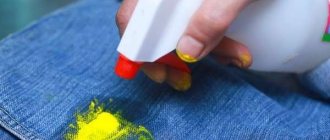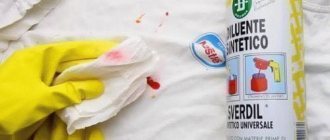Household chemicals and improvised means come to the rescue. Therefore, you should not throw away an item that has been exposed to persistent dye.
You need to start processing it immediately, before the composition dries. We'll tell you in this article how to remove oil paint from clothes at home.
How to quickly remove using traditional methods?
It is not always necessary to spend money on expensive stain removers to remove oil paint from clothes. Sometimes you can cope with the problem using home remedies that you always have on hand.
Powder and oil mixture
You can get rid of stains using butter and washing powder.
Features of using the method:
- Mix softened butter in an amount of 50 g with 80 g of washing powder.
- Apply the resulting mixture to the stain and leave for 15 minutes.
- Remove the composition with a paper napkin.
- Wash the item in warm water.
Use this recipe for any fabric. However, it may not be effective in treating old stains.
Solvent
Oil-based paint can be easily removed with an acetone-based solvent.
It is used as follows:
- a small amount of product is applied to the stain;
- leave the fabric for 15 minutes;
- wipe the contaminated area with a cotton pad;
- wash the item with soap or powder, paying attention to the contaminated area.
If you don't have paint thinner on hand, you can use nail polish remover. However, it must contain acetone.
Solvent is not recommended for removing stains from colored or delicate fabrics, as this will cause them to deteriorate.
Petrol
Gasoline is used to remove paint in its pure form. It is not diluted or mixed with other components. It is best to use gasoline that is used to fill a lighter, as it is free of impurities.
Removal is carried out as follows:
Apply gasoline to a sponge or cotton pad.- A piece of unnecessary material is placed under the back of the item so that the dissolved paint does not stain its other side.
- Rub the stain until it disappears. Movements should be circular, moving from the edge to the center.
- Wash the item in warm soapy water and rinse thoroughly.
As the cotton gets dirty, it needs to be changed so as not to stain the clean fabric with dissolved paint. You may need to change up to 10 disks in one procedure.
Turpentine
Turpentine can be used to remove paint from any fabric. It does not harm its fibers and does not wash out the pigment. The only drawback is that the procedure is carried out in several stages.
Sequencing:
- soak a cotton pad in turpentine;
- rub the stain in a circular motion towards its center;
- process the item on both sides: front and back;
- leave the product for 15 minutes to act;
- use paper napkins to blot the stain, squeezing it with your hands;
- Apply turpentine to the paint again and leave for an hour;
- rub the fabric with a toothbrush;
- wash the product with powder. You can use a washing machine.
If there is a greasy stain on the item, it should be sprinkled with starch or talc. Soft paper is applied to the fabric from the front and back sides and ironed. After this treatment, the item is washed again in warm soapy water.
White Spirit
White spirit is a petroleum solvent that contains gasoline fractions. It has the property of breaking down oil paints. The product is transparent, has no color, but it smells unpleasantly of kerosene.
To remove paint from clothing, you must follow these steps:
- Apply spirit to a cotton pad.
- Rub the stain thoroughly. The fabric should be well dampened.
- Leave the item for 20 minutes.
- Rub the stain with cotton wool again.
- Wash the product as usual.
When working with white alcohol, you need to use a mask or rubber gloves , since inhaling solvent vapors has a narcotic effect.
Removing oil paint from the body and face
Paint stains often appear on the skin, which happens when personal protective measures are not observed during painting work. Paint can get on your hands through torn gloves, and there are often splashes on your face. The paint should be removed without waiting for it to dry.
The skin on your face is delicate; you shouldn’t rub it too hard. It is usually recommended to use oil products - oil-based cosmetic liquids, peach oil (if they are not available, use regular edible oil). You can moisten a swab with the product and easily wipe off any type of paint. Afterwards you need to wash your face with glycerin soap or any cleanser.
It is quite possible to wash your hands with toilet or laundry soap, which does an excellent job of removing fresh traces of paint. The same means are used to clean the skin on the body if drops of paint and varnish have got there.
When paint dries, soap and oil often don’t do the job—more aggressive methods will be required. Acetone or acetone-based nail polish remover works well. It is important to scrub quickly and immediately wash off the acetone with soap and water, otherwise there is a risk of burns, allergies, and irritation.
How to urgently clean using chemicals?
If it is not possible to get rid of oil paint using improvised means, use household chemicals. Professional stain removers are sold both in stores and online.
When purchasing, you need to pay attention to the following points:
What fabrics is the product intended for? There are stain removers that are suitable for caring only for white or only colored items.- At what temperature does the product activate? Some cleaners only work in hot water, but not all fabrics can withstand such washing.
- Composition of the product. If it contains chlorine or other bleach, then it is not suitable for washing colored items.
- Release form. Liquid products are universal and can be used to care for any fabric. Powdered stain removers are not used for washing delicate items.
Before purchasing, it makes sense to read the reviews left by housewives. Be sure to read the instructions for use, which are printed on the packaging.
General action plan:
- Apply the selected composition to the stain.
- Rub the dirt towards its center.
- Leave the product on the fabric to work.
- Wash the item as usual.
The exposure time of the chemical varies depending on the composition. You can’t overexpose it to things, as this can lead to damage to the fabric.
Top 3 effective stain removers
The most effective stain removers for removing oil paint from things:
Remove It
This is a professional product for removing paint from fabrics. It contains a solvent that acts as an adsorbent. The product breaks down the coloring pigment, so the stain can be easily removed with a cotton pad. After processing is completed, the product must be washed .
The spray is suitable for removing paint from delicate fabrics, including silk and wool. You can purchase it online. The cost of a 100 ml package is 650-690 rubles.
Himitek Anti-vandal
This water-based liquid product is used to remove oil and other paints from textiles. It is applied to the contaminated surface and left for 10-20 minutes . Residues are removed with a napkin, in the direction from the outer border of the stain towards the center.
You can use the product in the form of a compress. After removing the composition, the item is washed. For 500 ml of the product you need to pay 720 rubles.
Dr. Beckmann
It is used to remove stubborn paint stains. The product is used for any fabrics, with the exception of viscose, modal and leather. The liquid is applied to the stain, left for 10-15 minutes, then wiped with a cotton swab . The completion of processing is washing the product as usual.
The cost of a 250 ml bottle is 180-250 rubles. You can purchase the product in specialized stores or on the Internet.
It is necessary to wear gloves when working with household chemicals. If the composition gets on an open area of skin, wash it with water.
Individual items of clothing
Oil and enamel paints are quite corrosive, and it is worth considering how to remove paint from clothes made of various materials.
- A leather jacket or trousers must be “saved” using vegetable oil: olive, castor or sunflower. Do not skimp on the oil, often change the cotton swabs you use to remove the paint, and everything will work out. Greasy marks from the jacket can be removed with ordinary laundry soap or dishwashing liquid.
- You should also remove stains from wool items in the same way. The remaining traces of fat should be covered with starch or talc, press this layer with a press, and when dry, clean it with a brush and wash it.
- Thin silk is treated with warm alcohol, then washed with soap and salted water.
- To wash white cotton fabric, first prepare a paste of white clay and gasoline and leave it for two or three hours. As soon as the gasoline evaporates, remove the slurry and begin washing. You can add stain remover or the already mentioned bleaches to the water. Another original way: prepare a mixture of a planed piece of laundry soap, one tablespoon of soda and a liter of water. Dip the soiled fabric into the boiling liquid for 10 seconds, then wash it with stain remover.
- Wipe your denim jacket or trousers well with gasoline or kerosene and then put them in the wash.
We recommend: 8 products that will remove red wine stains in no time
It is most often possible to wash off paint of one type or another without negative consequences for your favorite things. The main thing is not to try everything, but to choose a product depending on the substance on which the coloring composition is created.
How can I wash and remove dried stains?
To remove stains from dried oil paint, you need to follow these recommendations:
- Scrub the dirt with a wire brush, knife or blade. This must be done in order to clean off the top crust.
- You need to work carefully so as not to damage the integrity of the item.
- When the dry layer is removed, a cleaning composition is applied to the stain.
- To completely remove paint, the item must be washed.
If the stain was not removed the first time, the procedure should be repeated.
How to clean watercolor, gouache or acrylic paint?
If the incident happened with watercolor or gouache, then the answer to the question of how to remove the paint is very simple. These species are water-soluble, so they can be removed with water. If the stain has not yet dried, it is enough to rinse it well under running cold water. After this, soak briefly and wash as usual. Most often this is enough. If the trace is old, you may need to repeat it several times.
Water-based paint is somewhat more difficult to remove. It is acrylic compounds that usually have to be removed if you sit unsuccessfully on a freshly painted bench. It is also used for repairs, so it is useful to know how to remove this type of paint.
If the stain is completely fresh, you should first rinse it with cold water. Then wring out the item well and load it wet into the washing machine. Add washing powder and select the longest wash cycle. Repeat if necessary.
Acrylic paint is not always easy to remove. If after two cycles in the washing machine the dirt is still there, then you need to pour a small amount of powder on it and rub it with gentle movements. A toothbrush works well for this purpose. After this, you need to start the machine again, but at the highest temperature.
If it was not possible to wash the acrylic paint in this way, then you should use a stain remover or bleach. You can prepare the solution yourself. To do this, add a tablespoon of salt to 3 cups of water and two each of vinegar and ammonia. Soak clothes in one of these products for several hours, then wash. This method will certainly help clean up the traces of water-based paint.
If the paint is latex, you should use alcohol to remove it. It should be applied to a small piece of cloth and rubbed onto the affected area. When the fabric gets dirty, it needs to be changed. After the procedure, the suit should be washed.
Features of removal from different types of tissues
Features of removing paint from different types of fabrics are presented in the table:
| Fabric type | Removal Features | What not to do |
| Linen and cotton | Can remove paint at high temperatures. You can boil things if they are white. You can use any stain removers, including those containing chlorine, bioenzymes, active oxygen, etc. | Do not rub the contaminated area too hard to avoid causing pellets to appear. |
| Silk | Can be soaked in warm water. You can use liquid stain removers. Preference should be given to hand washing. Among the folk remedies for removing stains, turpentine and a mixture of powder and oil are suitable. | Does not tolerate washing at temperatures above 30 degrees. Do not use powdered bleaches, or products containing chlorine or other aggressive components to remove stains. Do not rub or wring out the item. |
| Synthetics | The temperature range for soaking and washing is 30-70 degrees. You can use powder stain removers. | Do not rub the contaminated area too hard or twist the wet item. It is prohibited to use solvents containing acetone. |
| Jeans | You can use a liquid stain remover, but it should not contain bleaching ingredients (for dyed jeans). Can be soaked for 30-40 minutes. Before using the product for the first time, you need to test it on an inconspicuous area of the fabric, since different jeans have different dye fastness. Stains are easily removed with gasoline, white alcohol, and kerosene. | It is not recommended to process items at high temperatures. Do not use aggressive bleaches or stain removers. Failure to follow these rules may cause severe shedding of the fabric. |
| Leather | To remove paint, you can use a gel stain remover for colored items. It should not contain chlorine or other aggressive components. You can clean the skin with turpentine, alcohol, or a mixture of powder and oil. However, you first need to treat a small area of the product and monitor its reaction. | Do not rub the surface with hard objects to remove dried paint. Do not use solvents to remove stains. Do not soak or wash at temperatures above 20-30 degrees. |
How to save clothes made of cotton, silk and wool?
If trouble occurs with cotton clothes, then you should try the following method. For one liter of water you will need a small spoon of soda and a piece of laundry soap, previously planed. The mixture should be brought to a boil, cool slightly and the affected areas should be immersed in it for a few seconds. Repeat as many times as necessary for the contamination to completely disappear. If streaks appear, the item should be soaked in warm water with bleach before washing.
The question may arise: how to remove paint from silk? This type of fabric must be handled with care. Laundry soap will help, they need to rub the stain thoroughly. Then heat the alcohol in a water bath, moisten a rag and wipe the desired area. When the paint comes off, you need to blot it with hot water, press it with a napkin and sprinkle it with talcum powder.
If you are wondering how to clean wool clothes, this can again be done with soap. Rub the stained area and then place it in boiling water for a few moments. Most likely, to wash it, you will have to repeat it several times.
It's useful to know how to scrub off paint if necessary. While it’s easy to deal with water-soluble ones, you’ll have to work hard to remove acrylic and façade ones. But there are ways to save clothes. After using special products, the outfit should be rinsed thoroughly. It is best to dry in the fresh air to remove the smell.
Important Tips
To get rid of oil paint and not harm the fabric and your own health, you must follow the following recommendations:
Do not allow cleaning products to come into contact with your skin or eyes.- It is necessary to work with gloves. When using odorous chemicals, you should wear a respirator or medical mask.
- You can only rub the stain with a white napkin or swab. It must be changed regularly so as not to transfer the pigment to a clean area of the fabric.
- Movements should be directed towards the center of the spot.
After removing the stain, the item must be washed and rinsed thoroughly.
Water-based paint
There are many types of water-based paint and each of them can be washed differently. Sometimes powder and stain remover are enough for washing, in other cases you have to use more serious products.
Water-soluble paints are the easiest to clean
Regular wash
First, try scrubbing the stains by hand using cold water and liquid detergent. If the paint does not work well, proceed to washing in hot water using powder.
Alcohol
You can clean water-based paint stains with alcohol. To do this, you need to stretch the cloth, moisten it with alcohol and rub the stains with a clean rag. The marks should disappear. Do not forget to rinse the item from alcohol and wash it.
Vinegar and ammonia
A special solution will help you remove paint from clothes at home.
Mix 1 tbsp. l. salt, 2 tbsp. l. vinegar and 2 tbsp. l. ammonia. Apply the mixture to the stain and scrub away the dirt with a soft brush. Dissolve the remaining mixture in water and soak the item for several hours. After soaking, wash as usual.
Delicate fabrics (silk, cambric, velvet, etc.) are best cleaned using high-quality and proven stain removers
Basic Rules
To remove stains without harming the product, follow the rules:
We advise you to read:
How to remove mulberries from clothes
- Fresh paint stains are easier to remove. If you notice that a child has sat down on the edge of a freshly painted sandbox, interrupt his play and lure him home. The sooner you start processing the item, the higher the chance of saving it.
- Never apply solvent to fabric without first testing it. Any substance must be tested by applying a couple of drops to an inconspicuous area of the material. If after 10 minutes you do not notice any changes in color or structure, the substance is safe.
- Any product must be turned inside out and a napkin or old unnecessary towel placed under the layer of fabric. When you try to wipe the stain off, the paint will print onto the bottom layer.
- Whatever you use to treat the contamination, follow the direction of movement. Move from the contours to the middle of the spot. This will concentrate the foreign substance in one place and prevent its further spread.
- The denser the material, the easier it is to remove contamination. It is much easier to remove dye from thick jeans than from a thin T-shirt.
Wash off the emulsion
Water-based paint washes off easily. You just need to not hesitate to take action. How to remove fresh paint from clothes? Wash the soiled item with laundry soap. You can throw your clothes in the washing machine and add a good store-bought stain remover and you'll end up with a clean item.
To remove old paint from clothes, first moisten the stain with alcohol. Under its influence, water-based façade paint disappears before your eyes. Does not help? Enhance the effect of alcohol with salt:
- sprinkle the stain with salt (about a teaspoon);
- pour alcohol on top of the salt;
- wait an hour and put it in the machine.
Hair dye
Removing hair dye is quite difficult, especially if time is wasted and the stain has dried.
Fresh stains should be carefully washed with cold water and washed with laundry soap. If there is no effect, try applying hairspray or 9% vinegar to the stain. Peroxide will do the job, but for colored fabrics you need to do a preliminary test on an inconspicuous area. Apply the selected product to the stain and wait 15-30 minutes, after which you can start washing.
For white fabrics, acetone or white spirit is also used. After such treatment, clothes must be rinsed before washing.
In some cases, regular laundry soap can help remove paint from clothes.
How to deal with paint marks on clothes
There are several basic rules regarding stain removal:
- It is necessary to act quickly, since dried and old blots are much more difficult to remove than fresh ones.
- You should choose a suitable remedy. Blind use of solvent can damage the fabric and ruin the item forever. Before removing a stain, it is necessary to determine the type of material and dye.
- Before removing traces of paint from clothing with a certain product, you should test it on a small area of the fabric. If the fibers do not break, the color does not fade and the texture of the material remains the same, then the product can be safely used on the entire product.
- Stains are processed from the inside out. Household chemicals and solutions according to folk recipes should be applied to the back of the product.
- After the procedure, the clothes are washed to remove the stain. Preference is given to detergents in the form of a gel.
Important! Before processing, you must read the product label, which states the composition of the material and washing rules. You should not neglect them, so as not to spoil the thing.











